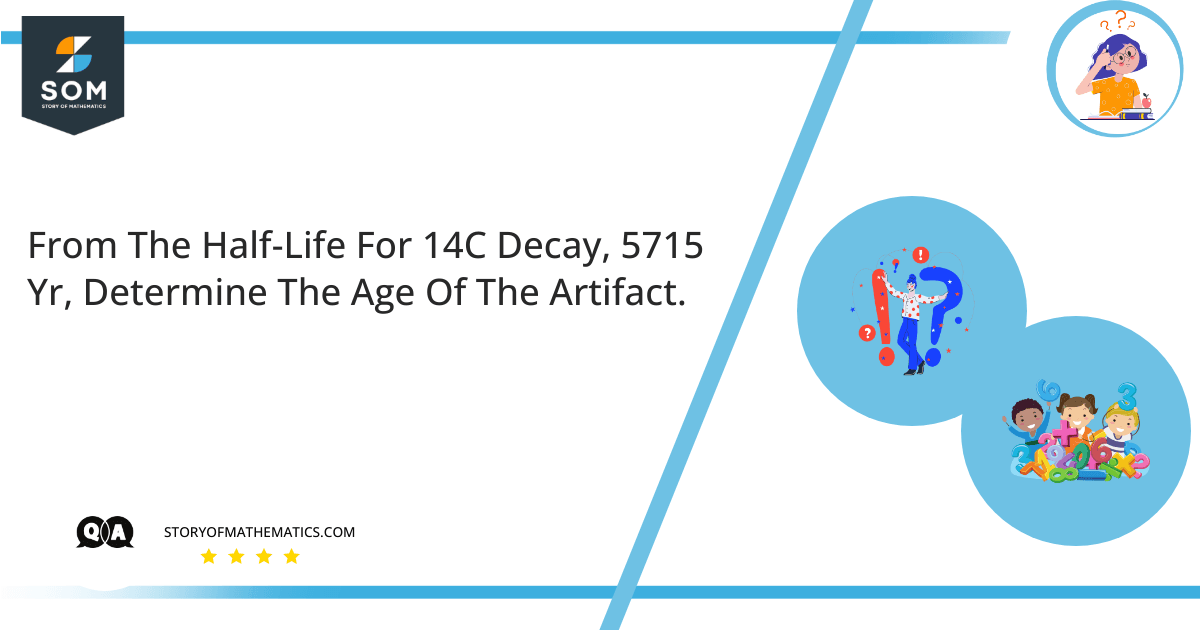
A wooden radioactive artifact present in a Chinese Temple comprising of $\ ^{14}C$ activity was decaying at the rate of $38.0$ counts per minute, whereas for a standard of zero age for $\ ^{14}C$, the standard rate of decaying activity is 58.2 counts per minute.
This article aims to find the age of the artifact on the basis of its decaying activity of $\ ^{14}C$.
The main concept behind this article is Radioactive Decay of $\ ^{14}C$, which is a radioactive isotope of Carbon $C$ and Half-Life.
Radioactive Decay is defined as an activity involving energy loss of an unstable atomic nucleus in the form of radiation. A material comprising unstable atomic nuclei is called a radioactive material.
The half-life of radioactive material $t_\frac{1}{2}$ is defined as the time required to reduce the concentration of given radioactive material to one-half based on radioactive decay. It is calculated as follows:
\[t_\frac{1}{2}=\frac{ln2}{k}=\frac{0.693}{k}\]
Where:
$t_\frac{1}{2}=$ Half-Life of Radioactive Material
$k=$ Decay Constant
The age $t$ of the radioactive sample is found in terms of its decaying rate $N$ in comparison to its standard decaying rate at zero age $N_o$ as per the following expression:
\[N=N_o\ e^\dfrac{-t}{k}\]
\[e^\dfrac{-t}{k}=\frac{N}{N_o}\]
Taking $Log$ on both sides:
\[Log\left(e^\dfrac{-t}{k}\right)=\ Log\ \left(\frac{N}{N_o}\right)\]
\[\frac{-t}{k}\ =\ Log\ \left(\frac{N}{N_o}\right)\]
Hence:
\[t\ =\ \frac{Log\ \left(\dfrac{N}{N_o}\right)}{-k}\]
Expert Answer
The half-life of $\ ^{14}C$ Decay $=\ 5715\ Years$
Decaying rate $N\ =\ 38\ counts\ per\ min$
Standard Decaying rate $N_o\ =\ 58.2\ counts\ per\ min$
First, we will find the decay constant of $\ ^{14}C$ Radioactive Material as per the following expression for Half-Life of radioactive material $t_\frac{1}{2}$:
\[t_\frac{1}{2}\ =\ \frac{ln2}{k}\ =\ \frac{0.693}{k}\]
\[k\ =\ \frac{0.693}{t_\frac{1}{2}}\]
Substituting the given values in the above equation:
\[k\ =\ \frac{0.693}{5715\ Yr}\]
\[k\ =\ 1.21\ \times\ {10}^{-4}\ {\rm Yr}^{-1}\]
The age $t$ of the artifact is determined by the following expression:
\[t\ =\ \frac{Log\ \left(\dfrac{N}{N_o}\right)}{-k}\]
Substituting the given values in the above equation:
\[t\ =\ \frac{Log\ \left(\dfrac{38\ counts\ per\min}{58.2\ counts\ per\ min}\right)}{-1.21\ \times\ {10}^{-4}\ {\rm Yr}^{-1}}\]
\[t\ =\ 3523.13\ Yr\]
Numerical Result
The age $t$ of the $\ ^{14}C$ artifact is $3523.13$ Years.
\[t\ =\ 3523.13\ Yr\]
Example
Radioactive Isotope of Carbon $\ ^{14}C$ has a half-life of $6100$ years for radioactive decay. Find the age of an archaeological wooden sample with only $80%$ of the $\ ^{14}C$ available in a living tree. Estimate the age of the sample.
Solution
The half-life of $\ ^{14}C$ Decay $=\ 6100\ Years$
Decaying rate $N\ =\ 80\ %$
Standard Decaying rate $N_o\ =\ 100\ %$
First, we will find the decay constant of $\ ^{14}C$ Radioactive Material as per the following expression for Half-Life of radioactive material $t_\frac{1}{2}$:
\[t_\frac{1}{2}\ =\ \frac{ln2}{k}\ =\ \frac{0.693}{k}\]
\[k\ =\ \frac{0.693}{t_\frac{1}{2}}\]
Substituting the given values in the above equation:
\[k\ =\ \frac{0.693}{5730\ Yr}\]
\[k\ =\ 1.136\ \times\ {10}^{-4}\ {\rm Yr}^{-1}\]
The age $t$ of the wooden sample is determined by the following expression:
\[t\ =\ \frac{Log\ \left(\dfrac{N}{N_o}\right)}{-k}\]
Substituting the given values in the above equation:
\[t\ =\ \frac{Log\ \left(\dfrac{80\ %}{100\ %}\right)}{-1.136\ \times\ {10}^{-4}\ {\rm Yr}^{-1}}\]
\[t\ =\ 1964.29\ Yr\]
